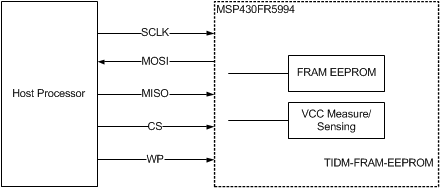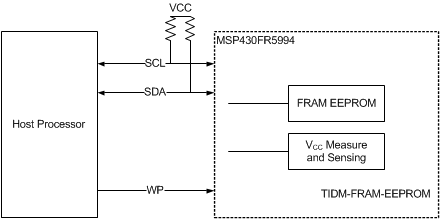SLAU678C March 2016 – November 2022
- Abstract
- Trademarks
- 1Getting Started
- 2Hardware
- 3Software Examples
- 4Resources
- 5FAQ
- 6Schematics
- 7Revision History
3.5.2 Operation
The EEPROM emulation is configured to use I2C or SPI protocol in Slave mode as indicated by Figure 3-7 and Figure 3-8. It would typically be connected to a host processor which would act as the master. This implementation, unlike traditional EEPROM, requires no caching after several hundred bytes. The host could continuously write data to memory once the communication is initiated. And the data is immediately written to memory. This means that the application could continuously stream data with much higher throughput. The SPI operation also includes DMA.
 Figure 3-7 EEPROM SPI Interface Block Diagram
Figure 3-7 EEPROM SPI Interface Block Diagram Figure 3-8 EEPROM I2C Interface Block Diagram
Figure 3-8 EEPROM I2C Interface Block DiagramThis reference design also emulates industry standard EEPROM protocols such as I2C and SPI, as well as a write protection pin to ensure that the device is protected from any writes. On top of EEPROM emulation, the reference design periodically samples the ADC for the latest VCC and temperature and stores it in FRAM at a low priority. When the host application requests the data, it is immediately available. The sensor data is currently configured to periodically sample every second and can be custom tailored for the application. The sensor reading does not block the EEPROM emulation. The EEPROM emulation is the highest priority function. For more information on this example, visit the reference design page.